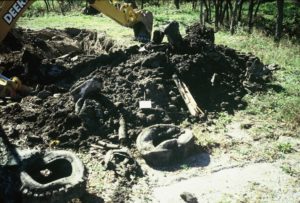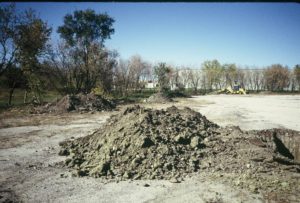Unlikely Havens

As I’ve mentioned previously, during the summer of 1965 I was employed as a mineral collector and fossil hunter for the Los Angeles County Museum, which is located on the edge of the suburb of Watts. On days when I was actually at the museum, I would spend my lunch break in the quiet and isolated rose garden, learning to cope with the German language, which was my nemesis in graduate school at UCLA. Sometimes, old Ernie*, the guard, would join me on his rounds, mocking my pronunciation with his deep, slow Southern drawl, and we would both crack up laughing.
One day my boss and I were returning from a field trip and noticed a greasy black smoke plume on the horizon, and supposed that an oil refinery had caught fire. Coming closer, it became clear that there was rioting in Watts and the little downtown was burning.
A month later the situation had sorta returned to normal, and I was German-ating again in the rose garden, when Ernie came by and invited me to see his garden on the edge of Watts. I pointed out the obvious, I was the wrong color, but he assured me that I was welcome with him.
So the next day we walked through many blocks of a shabby neighborhood until we arrived at his house with a tiny front yard somewhat reminiscent of the rose garden, because that is where his cuttings had come from. The deep back yard was enclosed by a tall, weathered board fence with no obvious access except through the house. The boards were covered with vines, on stick and string trellises. Fruit trees were toward the middle of the yard, pruned to be open and let some sun onto the green groundcover and the lined puddle pools. A hummingbird was busy working the abundant flowers, and a well-worn copy of a birding field guide was tucked under a dry ledge. His tally marks showed that at least nine of the fourteen hummingbird species known to migrate into Southern California had visited his little oasis.
The takehome message for me was that if a little yard in Watts could become a functional patch of habitat, then you could do it anywhere. Decades later, this would help shape my perspective as a consultant – that chemical spill sites, closed landfills, abandoned strip mines, oil leak areas, industrial wastelands, trashy vacant lots, and other ugly properties, were in fact opportunities waiting to happen.
One local example I was involved in reshaping is the Iowa City Eastside Recycling Center, which was featured in the January 2017 Heritage, Bur Oak Land Trust’s environmental journal. When Dave Elias and I studied the site back when it was just a concept in Dave’s mind, with his long experience with the City and mine as an environmental geologist, we concurred that the site was actually a landfill along the creek. Dave brought in a backhoe and I picked seven locations for large test pits and monitored the “stratigraphy” as the holes were deepened. All seven came up with fill dirt mixed with rubbish, tires and demolition debris. Fortunately, nothing nasty that could make the site unacceptable.

Before: A test pit containing tires, scrap iron, and lumber.

Before: The seven test pits being dug.
Because Dave was also the City landfill manager, he brought in heavy equipment and mined most of the big stuff out of the site, recycling what he could and properly landfilling the rest, while reshaping the site for its future use.
Had you seen the derelict “before” site in, say, 2008, you might have thought it an unlikely haven. But go check it out now, perhaps with a tour led by Brice Maren, the grounds manager. Call him at 331-0965.
When you are there, especially note the bioswales, which capture and treat parking lot and rooftop runoff, turning it into a green landscape. The photo that follows shows the bioswales a few years ago, when the plants were small enough to be seen as individuals, and where today it is a jungle. Also check out the new education building on the former landfill, which scored a LEED platinum, and is in the background of the bioswale photo, below:
*The guard’s nickname.


